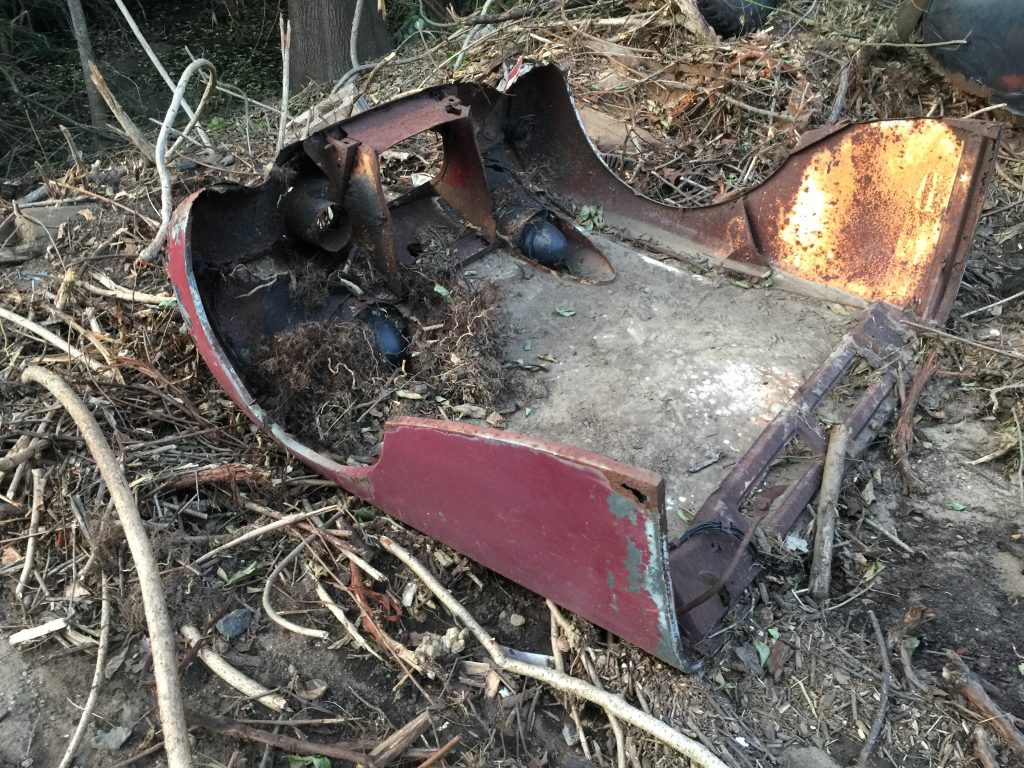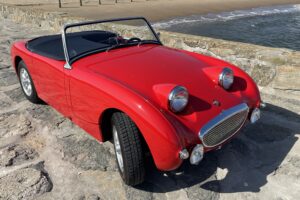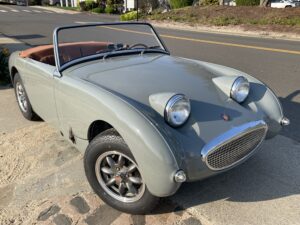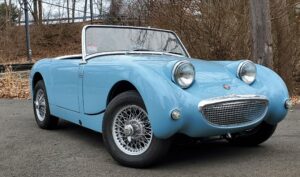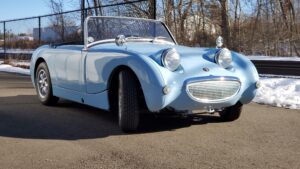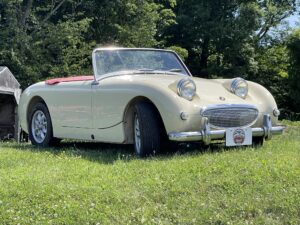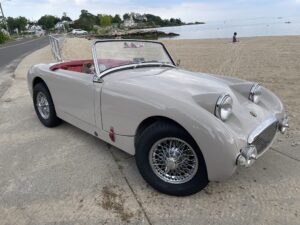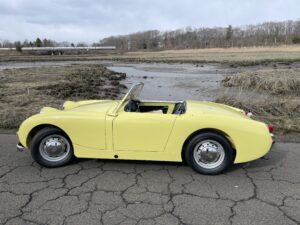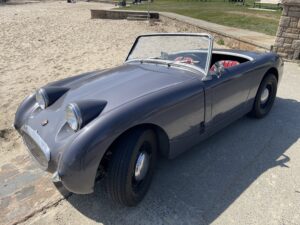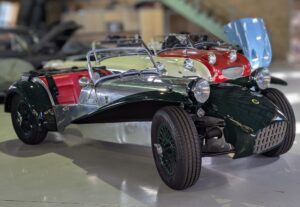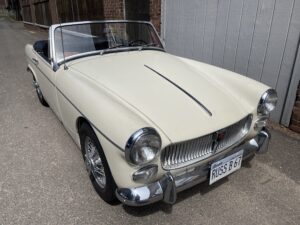We are excited to see our Frog-E electric featured in Automobile magazine’s website this week, click here to give it a read!
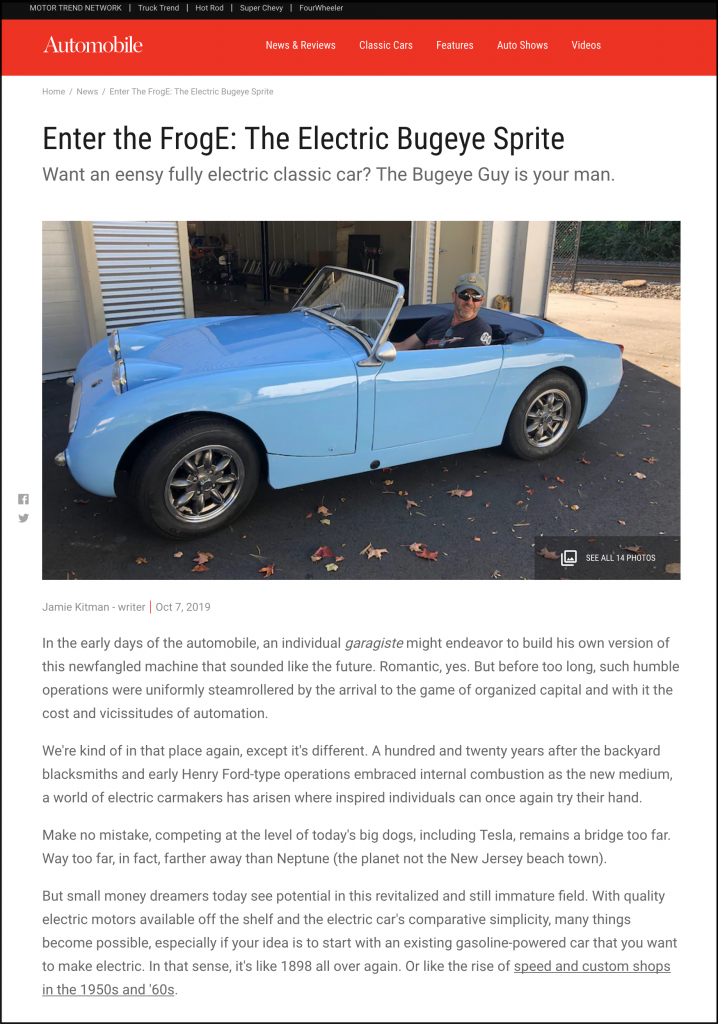
by bugeyeguy
We are excited to see our Frog-E electric featured in Automobile magazine’s website this week, click here to give it a read!

by bugeyeguy

NOW SOLD to Bill in Seattle, CONGRATULATIONS!
This is “Harvey,” (AN5L 10626) a 1959 Bugeye with a 948 engine and upgraded 1.5 inch carbs as well as front disk brakes. Also fit are new chrome wire wheels and new tires. We sold this car to a good man in Maryland who drove it roughly 300 miles in the past eight years, and we were more than happy to have the car back when he called because this is a nice one!

Chrome wire wheels and spinners look stunning. This is also a very accurate original leaf green re-spray, if you like this unique original color. Leaf green replaced dark green in the Bugeye line up at car #9927 in January of 1959. This car would have been built about 700 cars after that color change.

The car was restored and repainted probably 15 years ago. In 2006, the engine was rebuilt (receipt is included with the paperwork). I would guess that fewer than 1000 miles have been put on the car since the engine rebuild.

The car performs nicely and is a blast to drive. Interior is excellent. Nice top, tonneau and windows are also included. We just installed a new windshield glass and glazing rubber. We also put in new door seals.
Give a call if you would like to take Harvey home!

by bugeyeguy
Checked your tie rod end nuts recently?

A recent pre-departure inspection of one of our sold cars revealed loose tie rod end nuts. We noticed a tad of play in the steering, which we traced to loose nuts.
Please take a minute and check yours today, to avoid any issues down the road. It’s also smart to check the tightness of the front shocks while you are at it. Sometimes the three bolts holding the lever shock to the body of the car can also loosen-up.
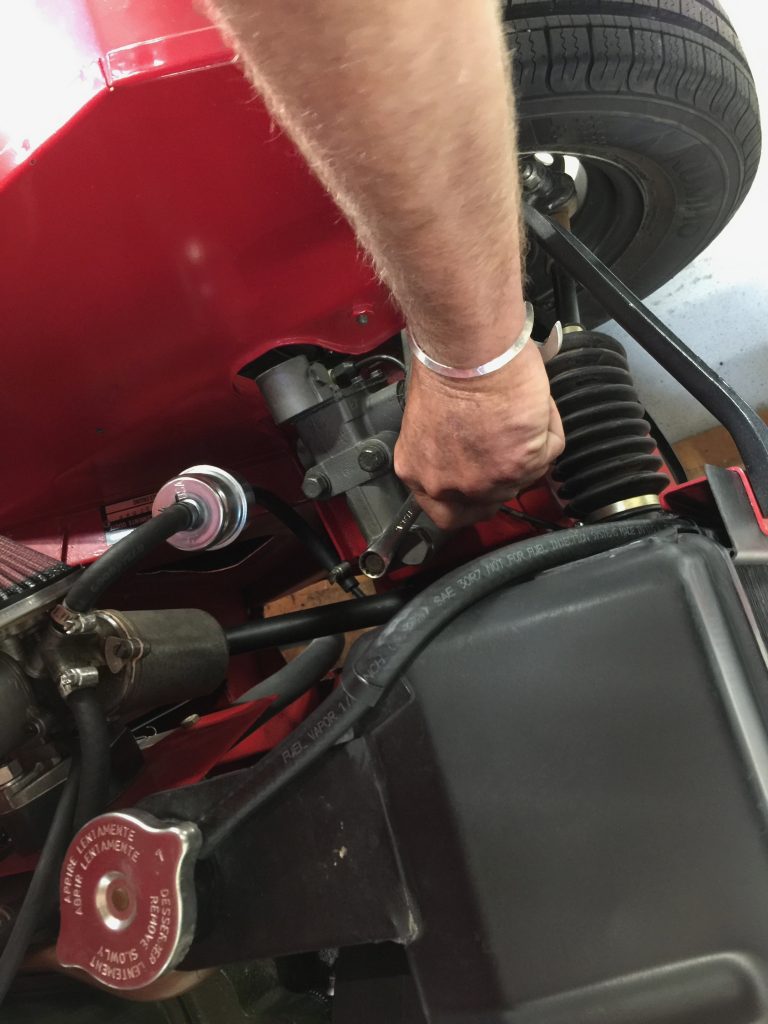
by bugeyeguy
In the video below, you will see the 1980 SCCA H Production runoffs, with about 25 Sprites battling for the national title. You’ll also see interviews with the lead drivers at the end of the footage, in decidedly 80s costume.
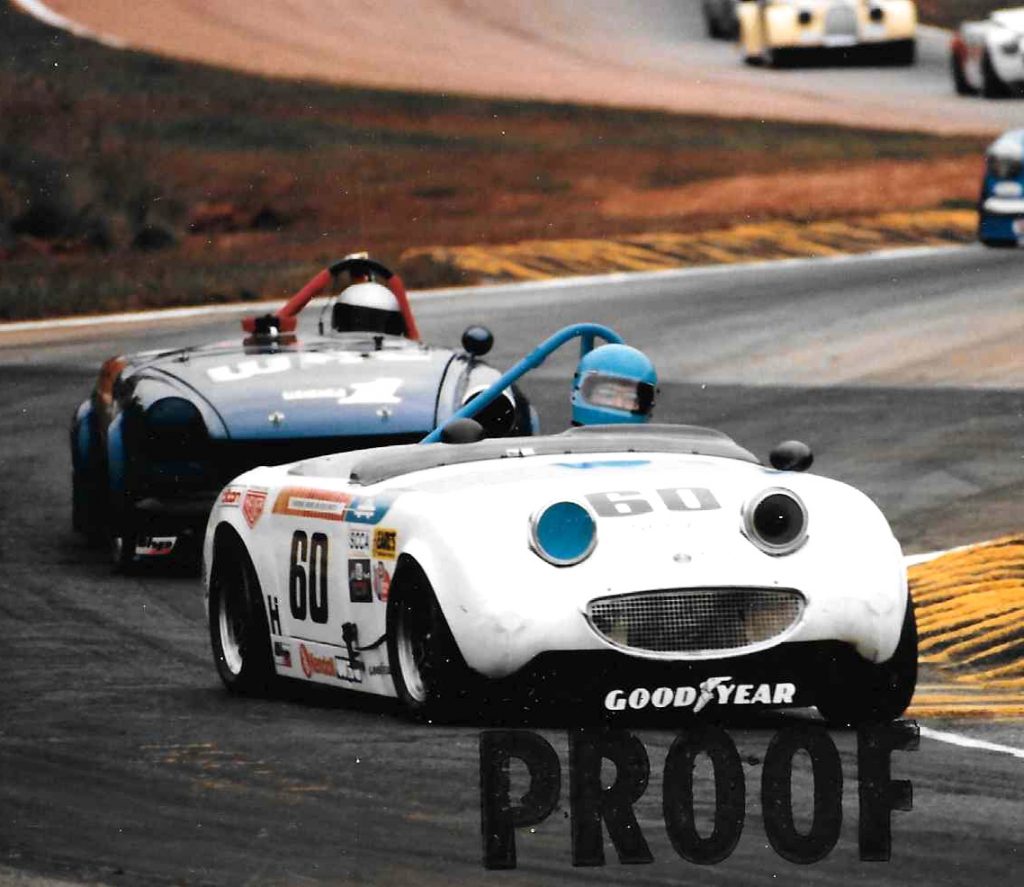
I love the video below because it takes me back to a time when I didn’t have 30,000 emails to process, instagram photos to post, and a smart phone to charge. I love and rely on technology and have used it to build our business. I also love the pure sportscar simplicity (and Sprite popularity) evidenced in this video. And David Hobbs as commentator is a nice bonus.
Feel free to skip around in the video (the race starts three minutes in) and enjoy!
by bugeyeguy
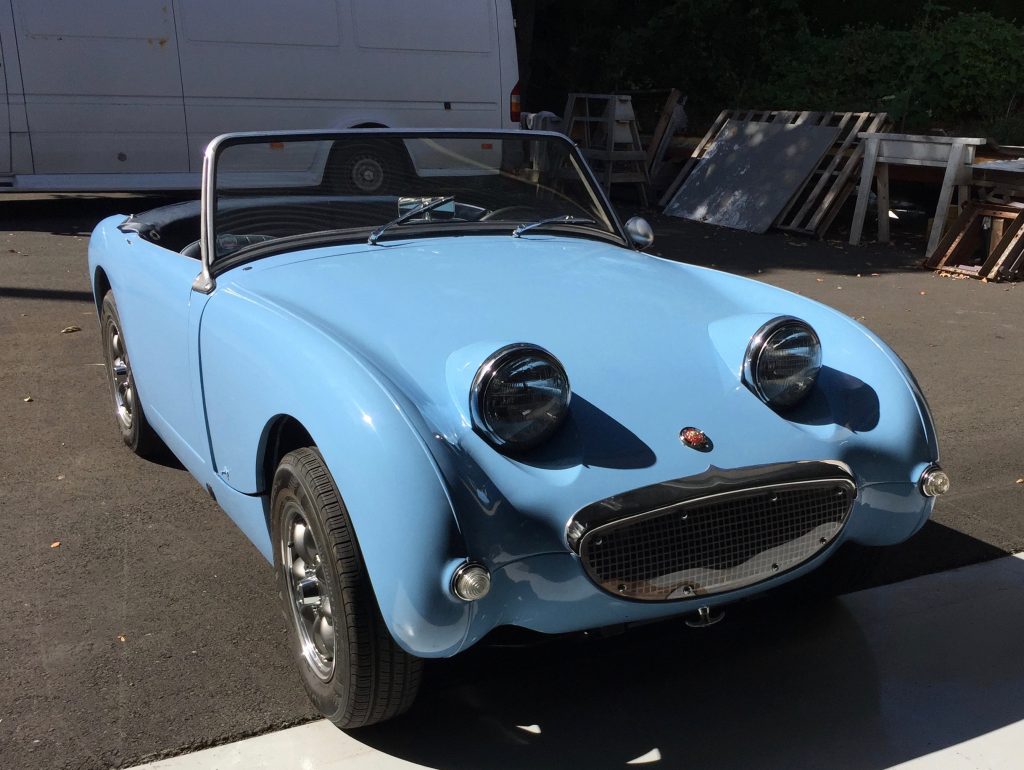
FrogE #2 is nearly done and nearly ready to send to its home in Maryland. We have just a bit more testing to do, including a long highway drive next Sunday September 29 to the Fairfield County Concours in Westport, CT, where the car will be displayed as part of an exhibit highlighting electric sports cars. Come say hello!
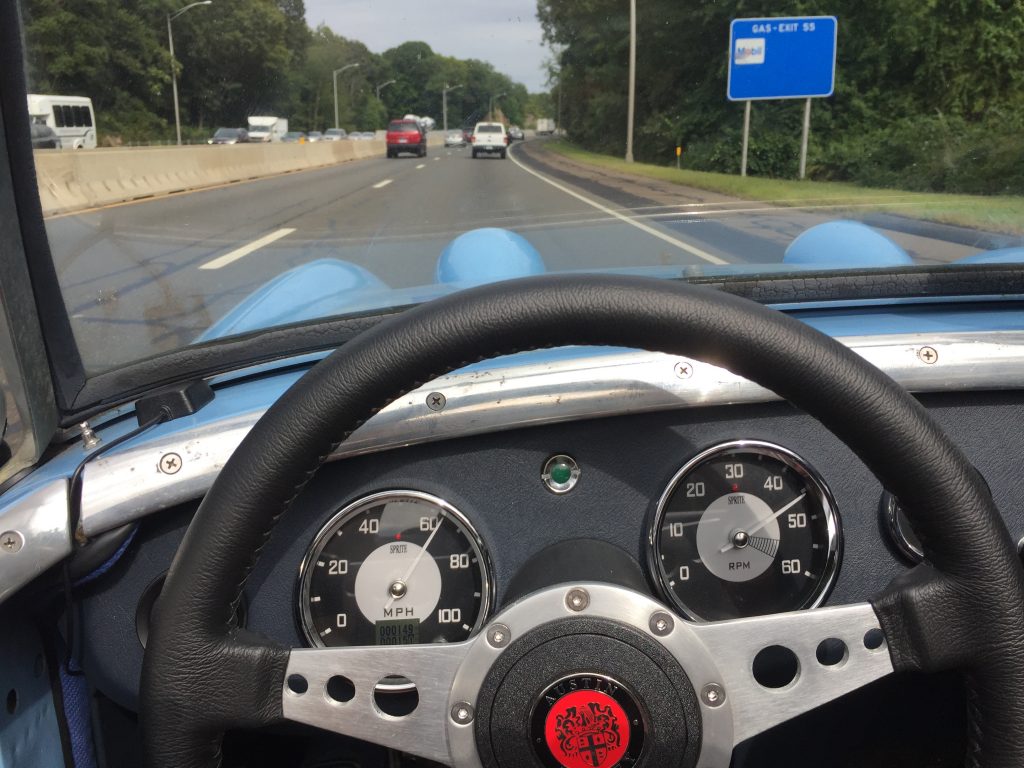
This week, we changed the rear leaf springs and raised the car, then shimmed it down to the right height. You might be able to see the difference from the photo we shared last week. Now the car sits with a few inches gap between the fender tops and the top of the tire (at 12 o’clock). It was bottoming out and hitting the bump stops on hard bumps with the original (and sagging) springs in place, and the new springs fixed that issue and dramatically improved the ride quality.
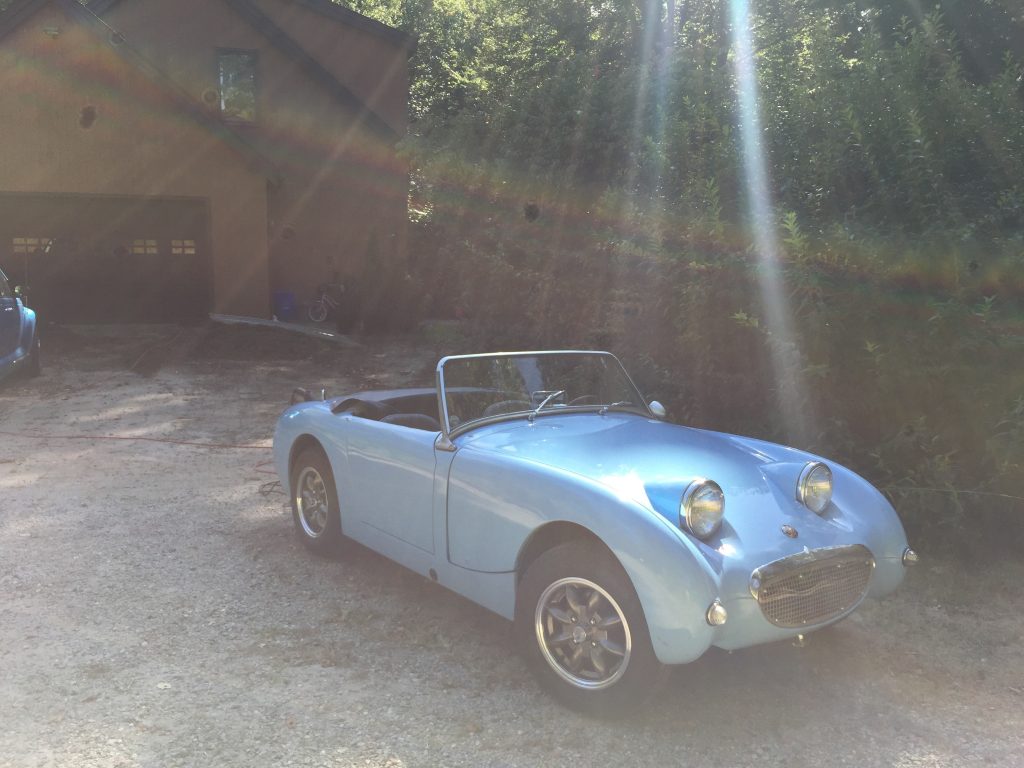
Our biggest recent breakthrough was to boost the charger peak voltage so that we could finally determine maximum range for this particular battery configuration. It turns out we have 81 miles of range, with combined highway and city driving.
I drew the short straw to verify actual range in the field. The onboard volt meter tells us the capacity but this is non-linear chemistry, so range is not directly correlated to voltage. The volts stay stable for most of the capacity, and then fall off rapidly when the pack is running low. Off I went to determine the actual range on the road. Ironically, many Sprite fuel gauges read full until you have burned half a tank, and then the gauge falls more rapidly. The electric “fuel” gauge behaves in a similar fashion.
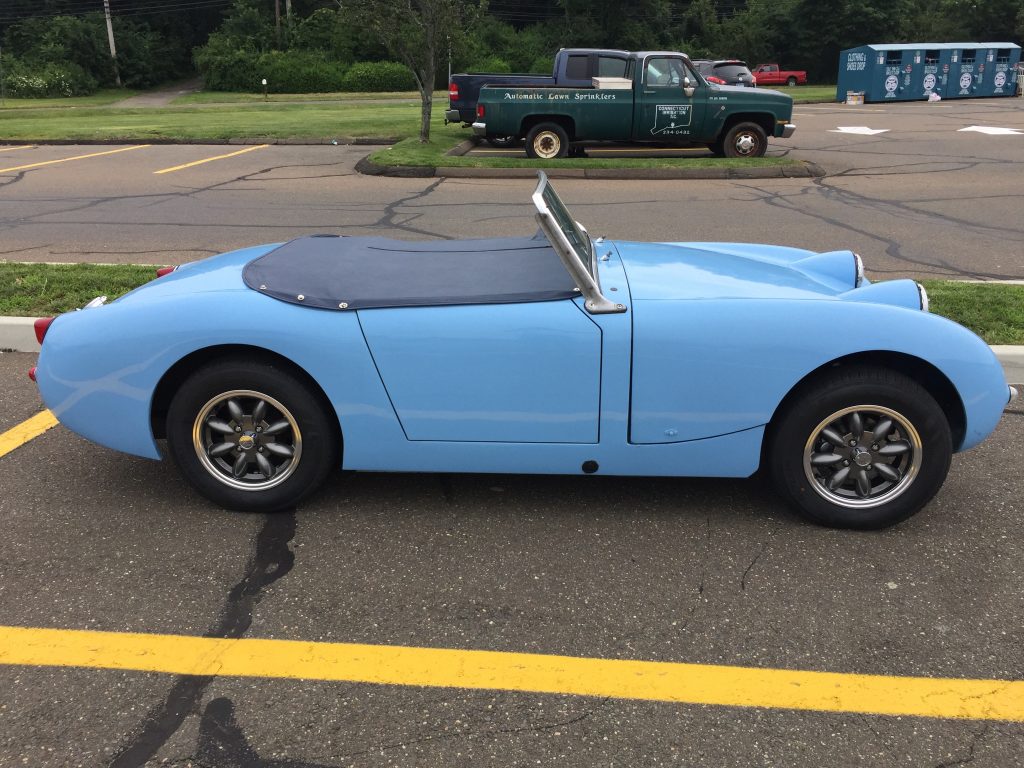
At 81 miles traveled, the controller derated and reduced available power, which told me it was time to pull over NOW. Adjacent at this moment was the house of the fellow who does our landscaping, and I figured he might just have an extension cord to help me make it back to the shop. There was no answer at the front door, but sure enough, in the driveway I found a 50 foot extension cord next to an outdoor 110 outlet, and I immediately plugged into the grid.
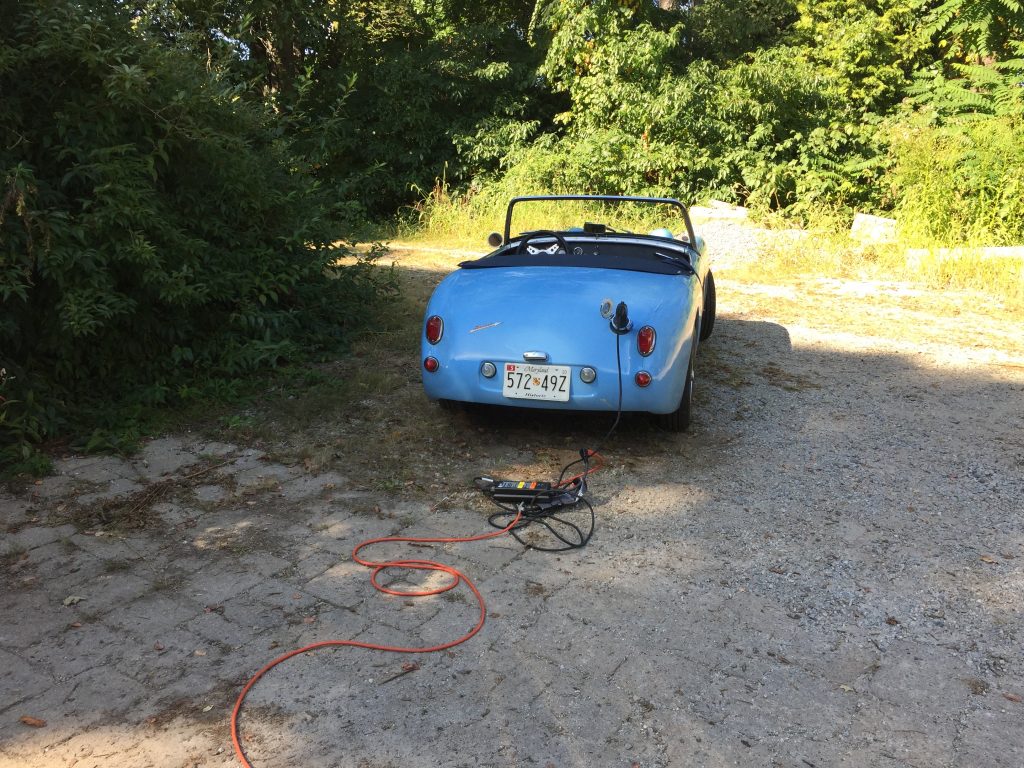
In this moment, it sure seemed like finding power was easy… just turn down any driveway and fill ‘er up. 110 power limits the rate of charge though, so it’s really only for emergencies. The 220 charger in our shop is quite a bit faster, and public charging stations are faster still. Regardless, this was what I needed to make it home, and after an hour of smart phone calls and emails, I coiled up the extension cord and hit the road.
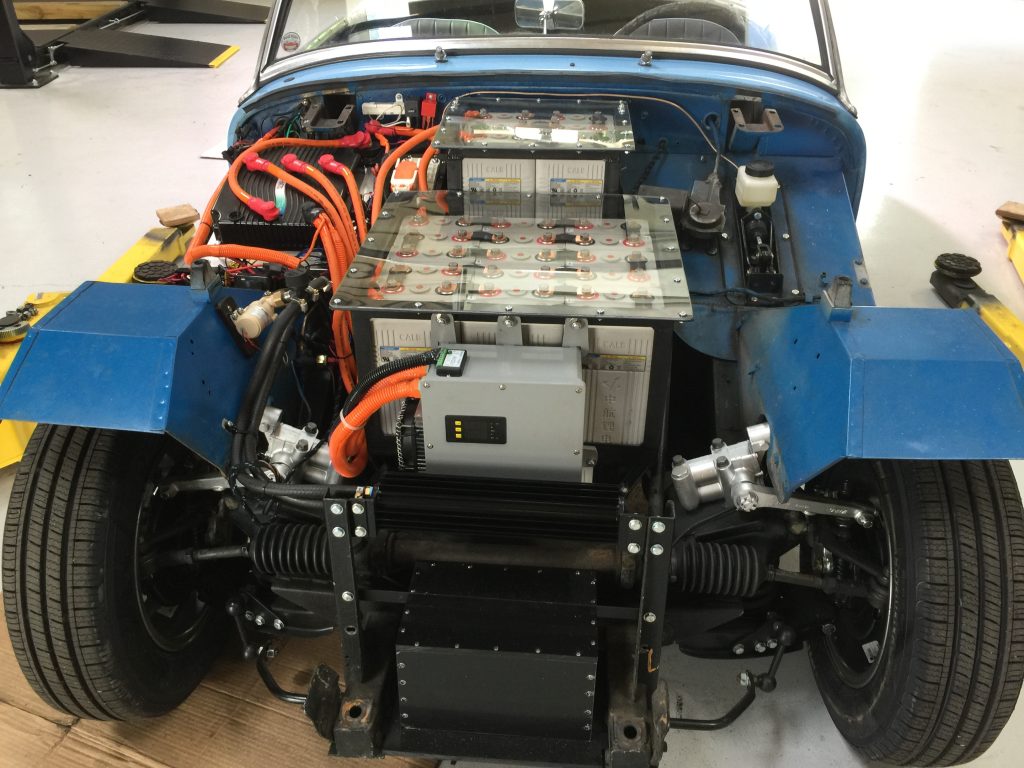
We had hoped for more range, but this particular battery pack (and other factors) limit us to roughly the 80 mile mark. We always have the option of supplementing our range with a Tesla pack… these batteries have a greater energy density, and while they are only available used, they should have a 20 year lifespan so this is an option for people who need to travel further on a single charge.
That said, having lived with this car for a few months of testing, I was surprised how long it takes to use-up a full charge. It’s rare that we set out for an 80 mile Bugeye drive, and I suspect it’s rare for our customers to do the same. Sure, there are some folks who routinely make long trips, but they’re probably not interested in electrics for that application anyway, at least not yet.
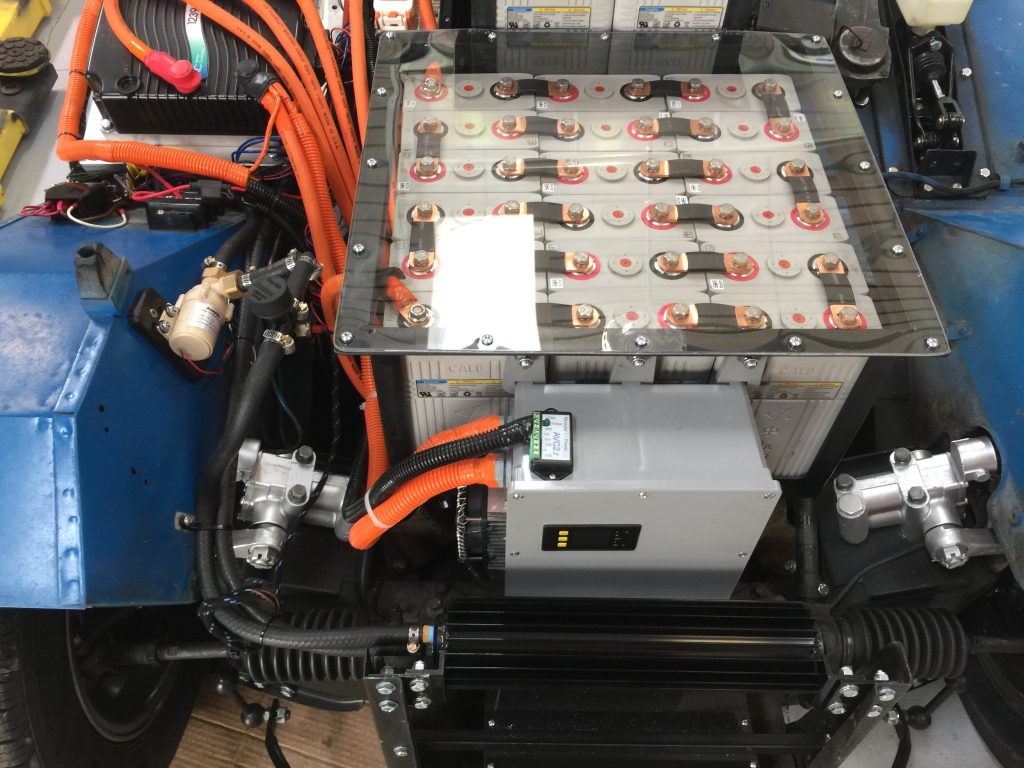
Most of our Bugeye outings have been relatively short hops of 20 miles or less. Here in the Northeast, that works nicely, and a 20 mile drive takes us where we need to go and provides ample time to enjoy a fun drive in a Sprite. Thus, I have become convinced that 80 mile range works just fine, especially if you recharge after every 20 mile journey, and depart each day with a full 80 mile range. For most customers, that’s ample capacity to head to the beach or apple orchard, run some errands, or go visit a friend, and return home for a recharge, with ample reserve.
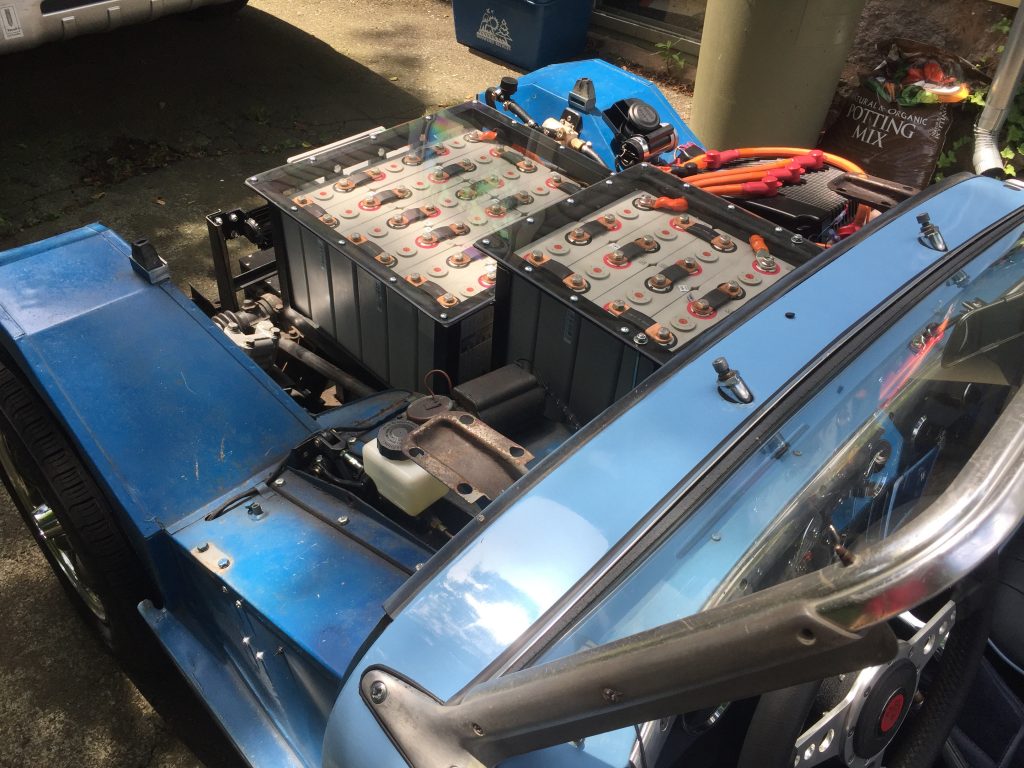
This week, we will be upgrading the car’s onboard charger so that it charges twice as fast. This will make off site charging sessions twice as productive. The more powerful charger will allow us to completely fill the discharged batteries in 8 hours, and to also boost 25% more range from the system with a two hour public charging station stop. For example, 100 mile range can be attained with a two hour boost stop.
I have a 72 mile round trip journey to Westport next weekend for the concours. I’ll probably plug in for 30 minutes at the Westport train station before I head home, just to play it safe.
by bugeyeguy

The Bugeye-lover above paid us a visit last week to explore our universe and he subsequently forwarded a video of his field trip, which you can enjoy below. The video stars our Bugeye “Prim,” which you can see (for sale) in the gallery above.
Thanks Geoff!
by bugeyeguy
Ride height is forever a challenge in Bugeye-land. This is primarily because no one makes a correct leaf spring anymore. There appears to be just one new quarter-elliptical Bugeye leaf spring available worldwide, and it is a ten leaf version that is too stiff and too high.
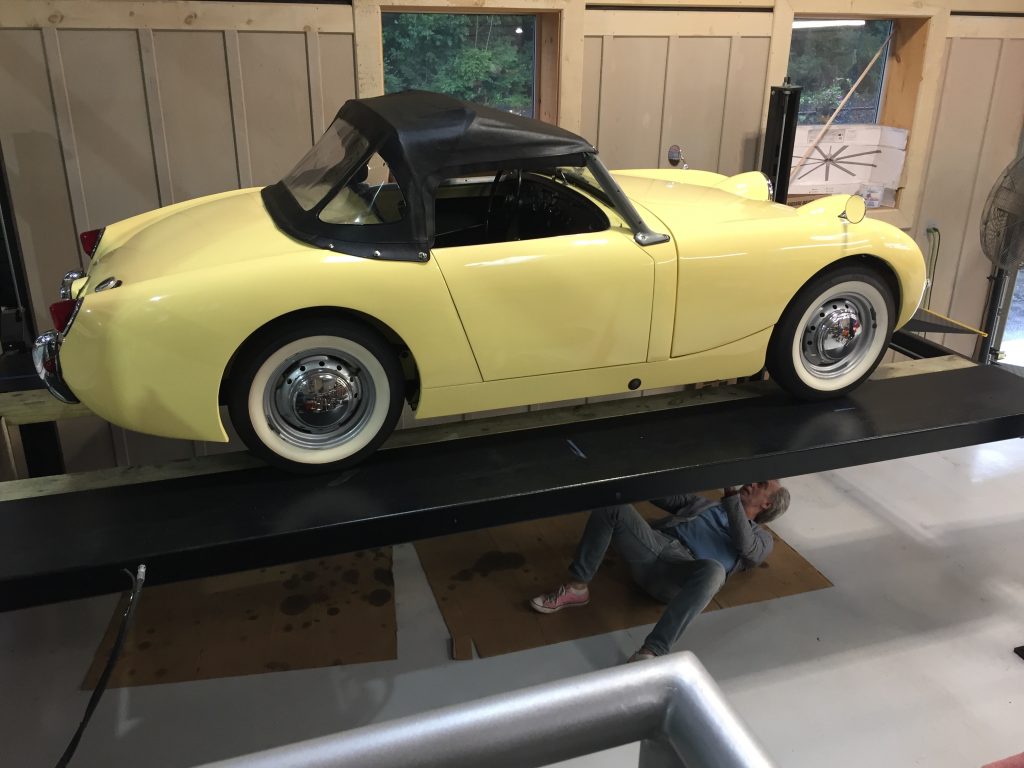
Spring shops are harder and harder to find, and to re-arch the springs requires lots of flame and black-smithery, which is not exactly available on every street corner these days (nor is it a growth career). In short, if you want the correct spring, it seems you need to go East on a pilgrimage and order a whole lot of them, which is something we have been unwilling to do.
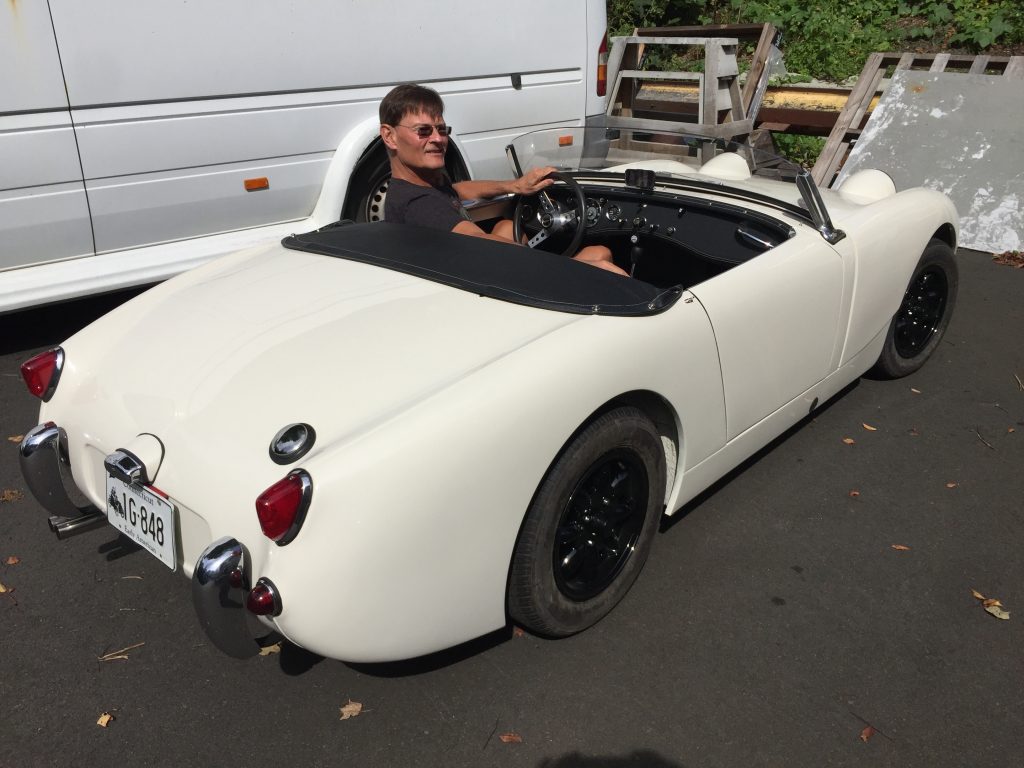
And so we have been using lowering wedges which work nicely to adjust the spring height in the back of the car, and our lowering kit in the front. With these parts, you can take a new ten-leaf spring and shim it to attain the proper height, which is exactly what will do on the car pictured below.
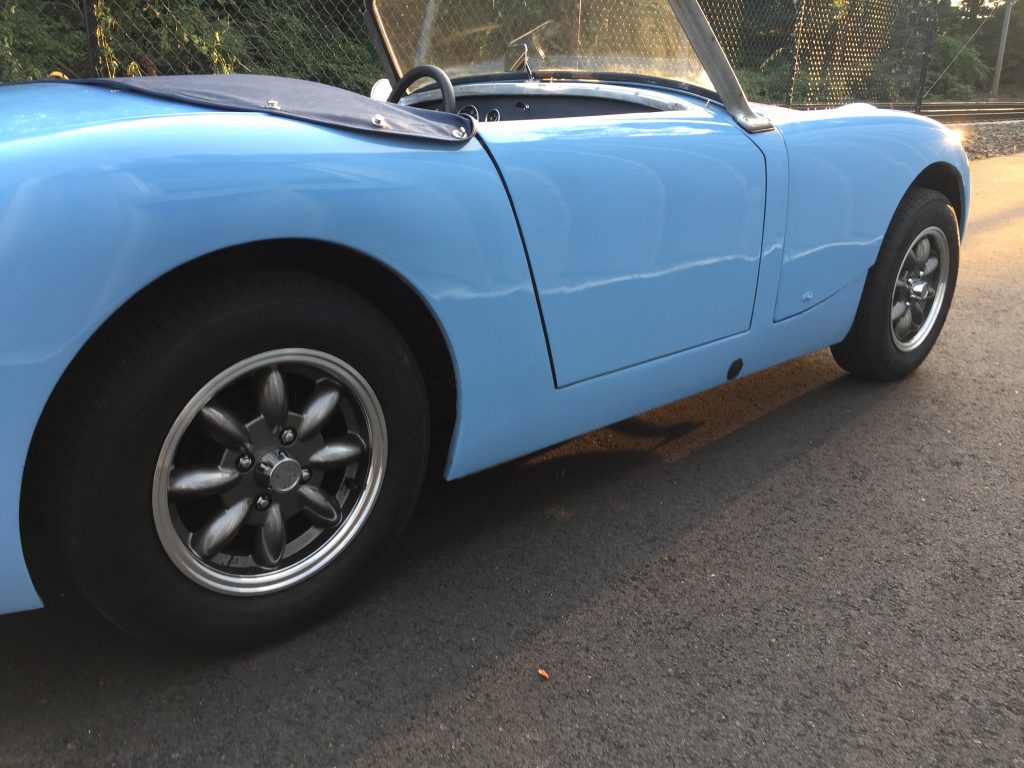
The image above shows our latest electric conversion. This car has seen a lot of miles prior to our conversion and you will notice that the rear end is slightly lower than the front.
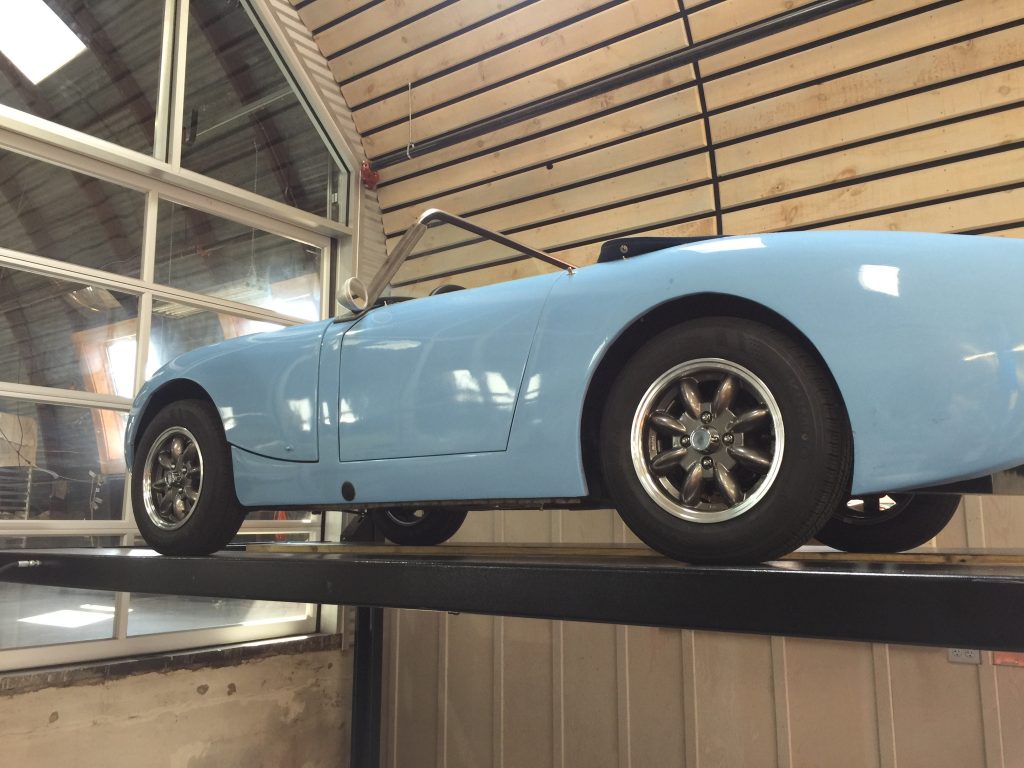
This is rare. Usually, the rear end sits taller than the front (as you can see in the example below). This particular blue car above has the original 15 leaf springs, and they have sagged after a hard life. The car is bottoming-out on big bumps, and so it is time for these springs to be changed to something more effective.
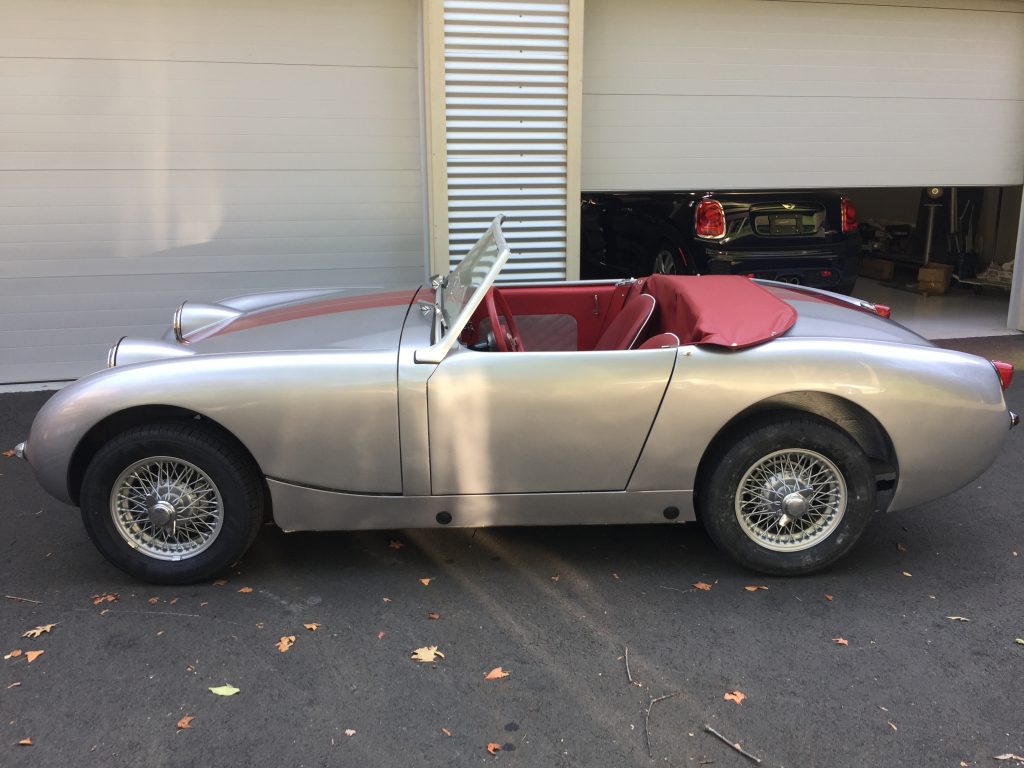
We will put in the new ten leaf springs and then use our shims to lower the rear of the car to a more normal looking parallel height. If you want to order rear shims or a front lowering kit, click on the links here, so you can adjust your ride height! We sell new ten leaf springs too!
by bugeyeguy
I love this book.
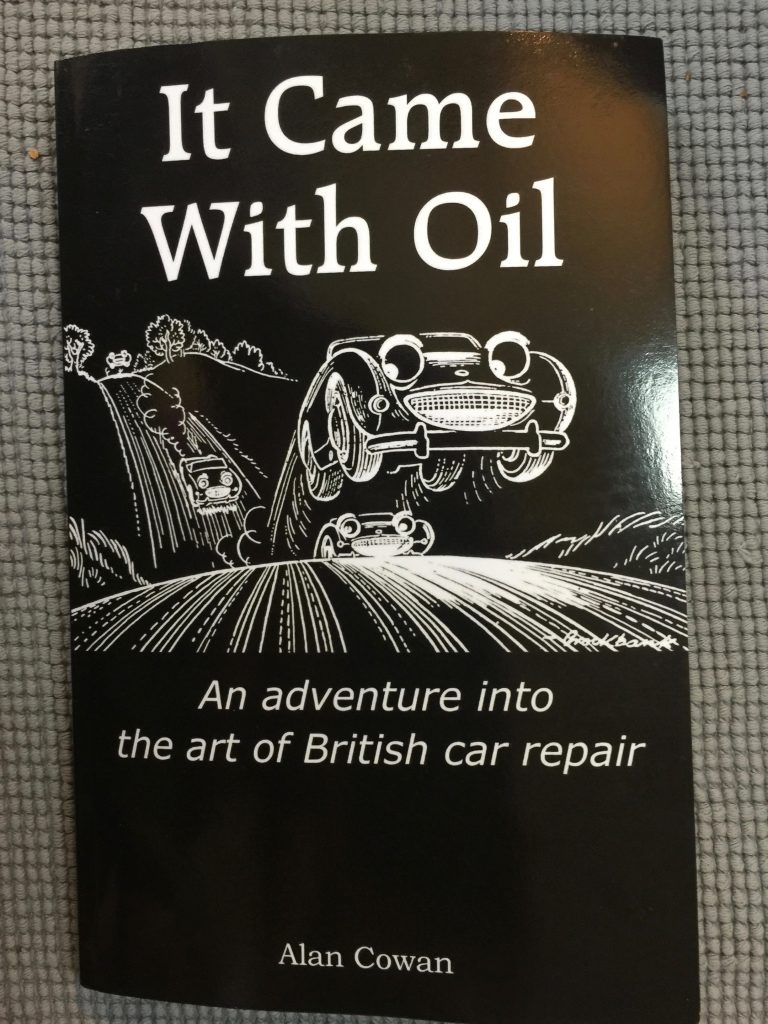
This is a compilation of the trials and tribulations of a restoration mechanic/shop owner. Within these pages, you will find fun stories about broken things and how they might be repaired on the side of the road. You’ll also find the sense of humor most Bugeye owners enjoy, from a wise author with a great perspective about how cars, conveyance and our culture have changed through the years.
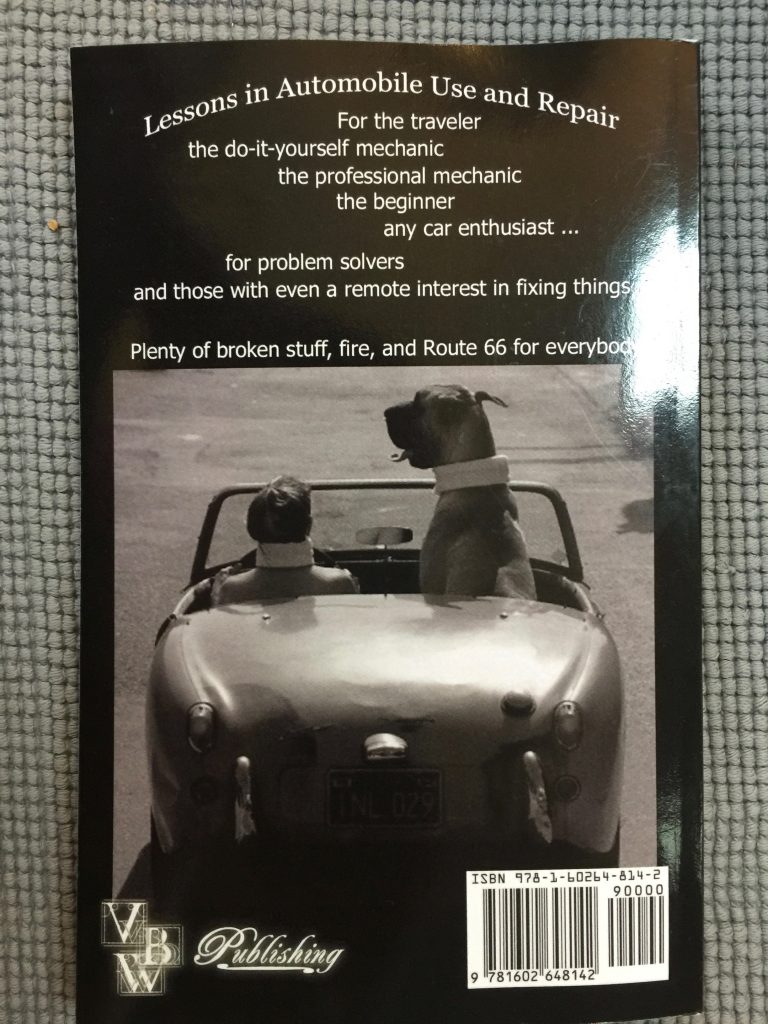
The title is rooted in a conversation the author had with a customer who limped into his shop, with a clattering sleek and new Range Rover. When he asked when the oil was last checked or changed, the owner said, “It came with oil, didn’t it?”

This is a book for anyone who grew up when cars were user-serviced and occasionally uncomfortable (although he also writes about his Hudson with seats that folded into beds).
Recommended! You can order your copy by clicking here.
by bugeyeguy

We have had a busy week, preparing a few more Sprites and sending them on to new homes. We’ve now sold 256 Bugeyes. It wasn’t long ago that we crossed the 100 car mark, and that seemed unimaginable to me. Our current Bug-o-meter total of 256 is a number that fills me with tremendous gratitude, for a glorious journey and a great team that helps make it all happen.
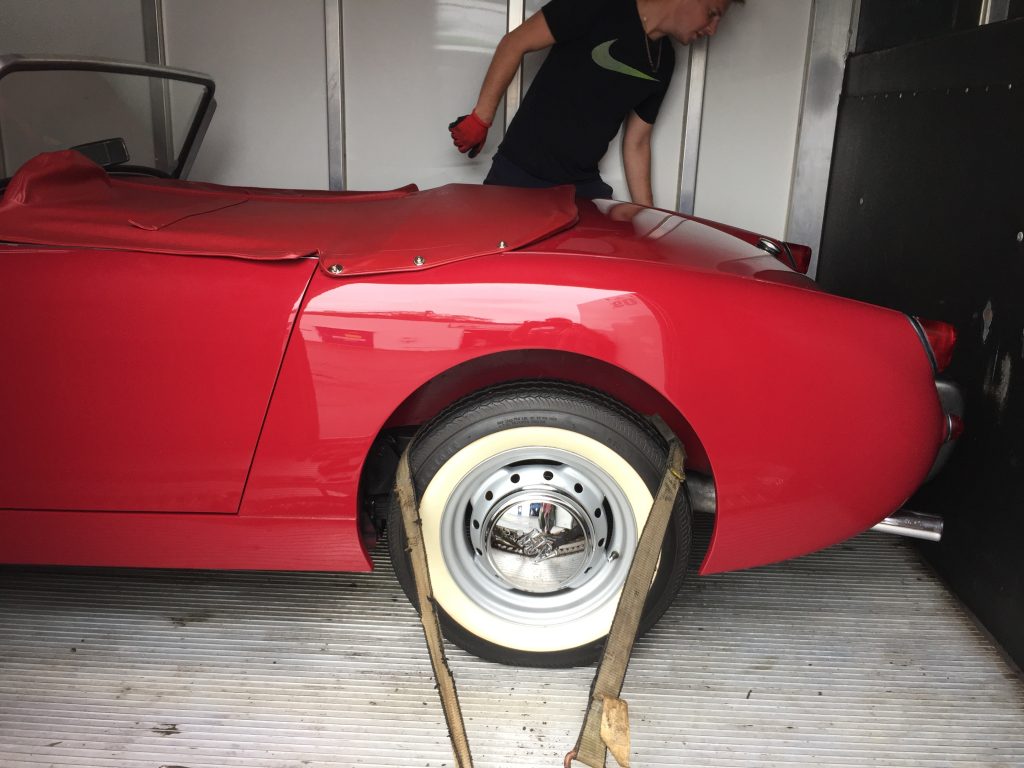
I can’t help but wonder what kind of difference 256 Bugeyes makes in the world, as they actively run around and elicit smiles from pedestrians, passing motorists and owners alike. If one Bugeye makes one person smile at a rest area or filling station, what impact has 256 healthy Bugeyes upon the world? We hope to shift this country’s happiness quotient, one Bugeye at a time.
Above you’ll see David from Martha’s Vineyard, smiling with his new Bugeye “Hudson,” later loaded in an enclosed trailer for delivery. That particular car came with the original bill of sale, which is reproduced below and worth a closer look.
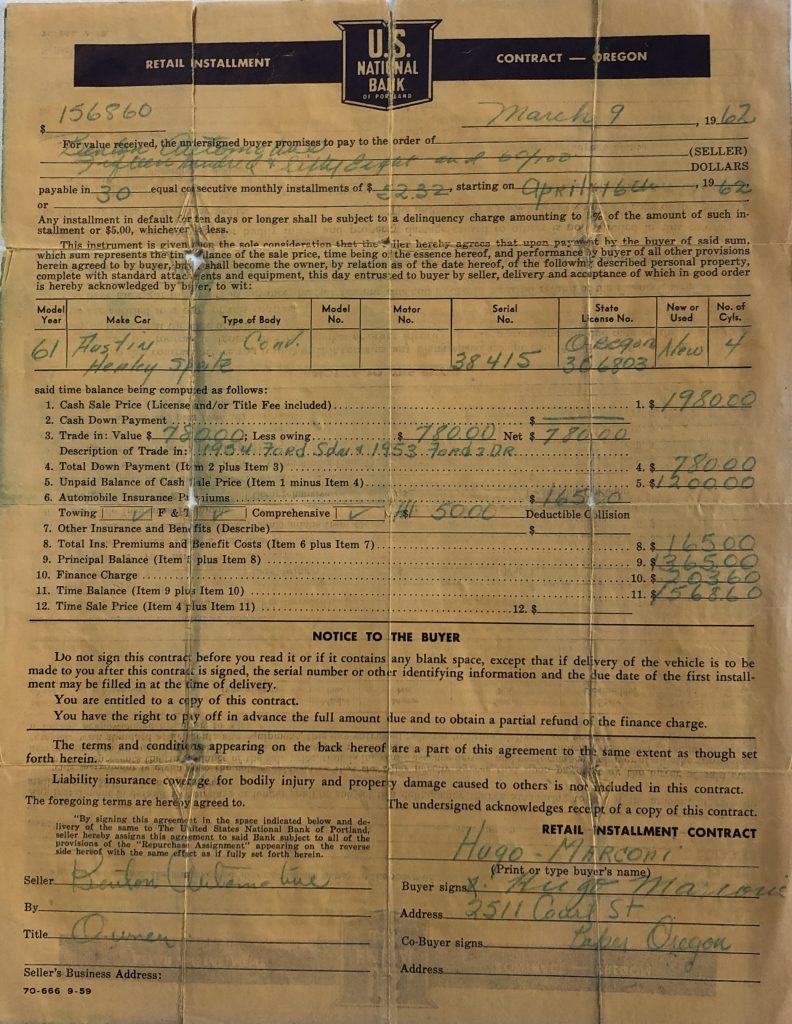
This car was sold new on March 9, 1962, for $1,980. Mr Marconi traded in TWO cars on that day, a 1954 Ford sedan and a ’53 Ford two door, with a total trade in value of $780. This left him a balance due, which he paid off in 30 installments of $52.32 (also note the mere $50 deductible for collision).
So, for less than the price of your monthly cable TV bill…
Also of note is the timing of this transaction. We know from production numbers that this car, car number AN5L 38415 would have been built in 1960. It was listed as a 1961 model even though no USA models were supposedly built after 1960. Moreover, it was first sold in March of 1962. How could this handsome car have sat with no suitor for all of 1961? Here is one more story of BMC dates and numbers that are difficult to reconcile. All that we can really know for certain is that this particular car was sold new in March of ’62.
Congratulations on your purchase David, and thanks for keeping the original cherry red color and original bias ply white walls in place, on your restored car! May you keep it as long as Mr Marconi (more than 20 years)!
by bugeyeguy
I received a call this week about a Bugeye for sale that was “a bit rough.” The price was $800, but he would take $500 cash. To make matters more urgent, he said that someone was coming to grab it Saturday with a trailer and cash in hand, but no money had yet been exchanged, and as a courtesy, he wanted me to have a shot at bringing this classic back to life.
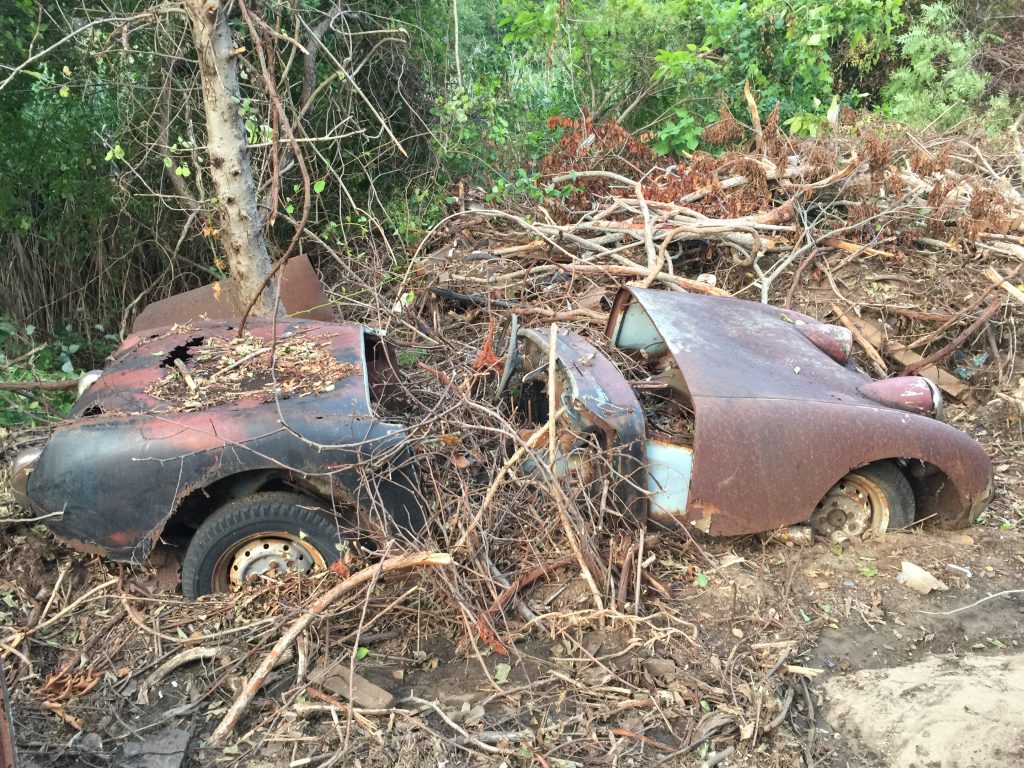
As luck would have it, I was planning to be just .7 miles away from this investment opportunity that very evening, and so I decided to stop by for a look.
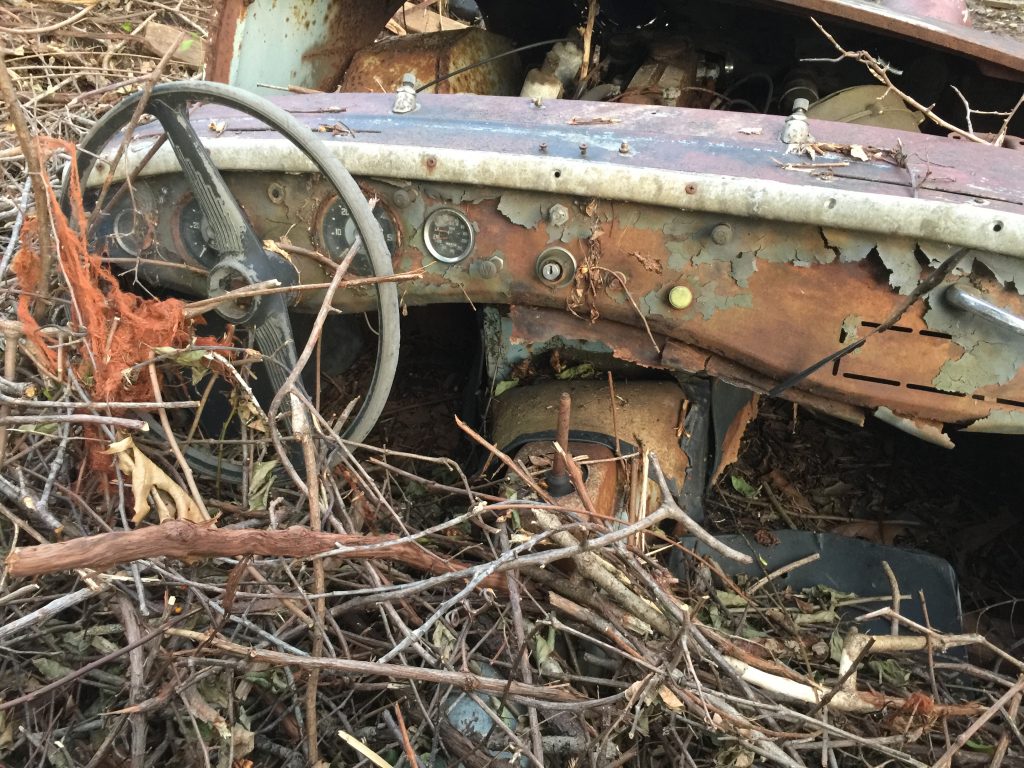
What I discovered was a self-composting Sprite.
I started to make a mental list of what might be saved here. An original dashboard has value. And the gauges can be restored, after all, they have been shaded all these years by the cowl. And the steering wheel is restorable, as is the cockpit trim.
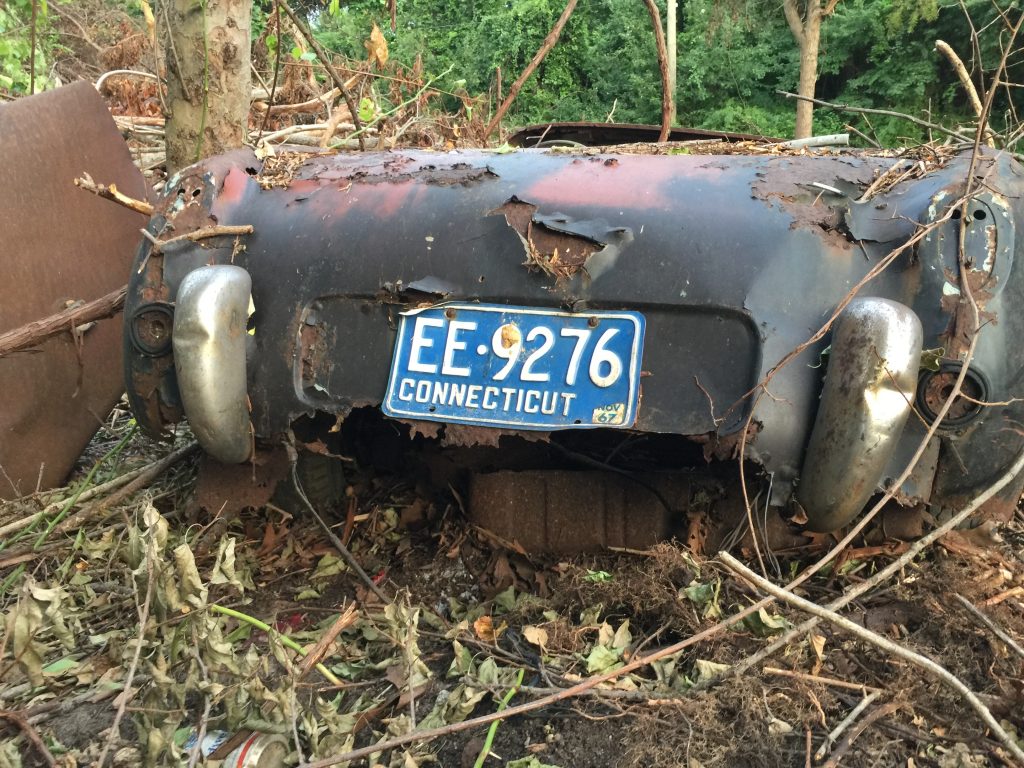
As I thought about what it would take to liberate the fasteners holding each of these parts in place, I marveled at the pull of gravity as a non-negotiable force, on the fuel tank, for example. Long after the gasoline evaporated, and the varnish left behind had outgassed, the top of the tank rusted through, filling the tank with water, which eventually rusted the floor of the tank.
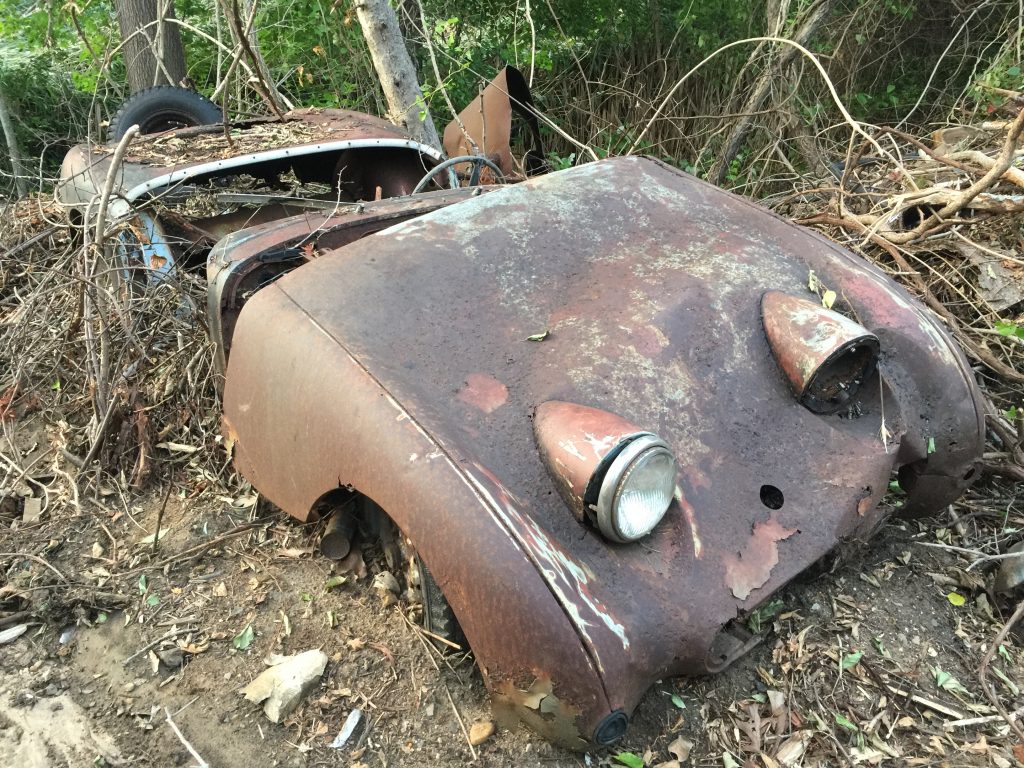
Perforated on top and bottom, the weight of the now lacy and empty tank itself was still sufficient to have it fall to the earth, as the trunk floor finally evaporated after one last terminal rain drop. Who needs the The Lion King? British classic car lovers have long embraced the circle of life.
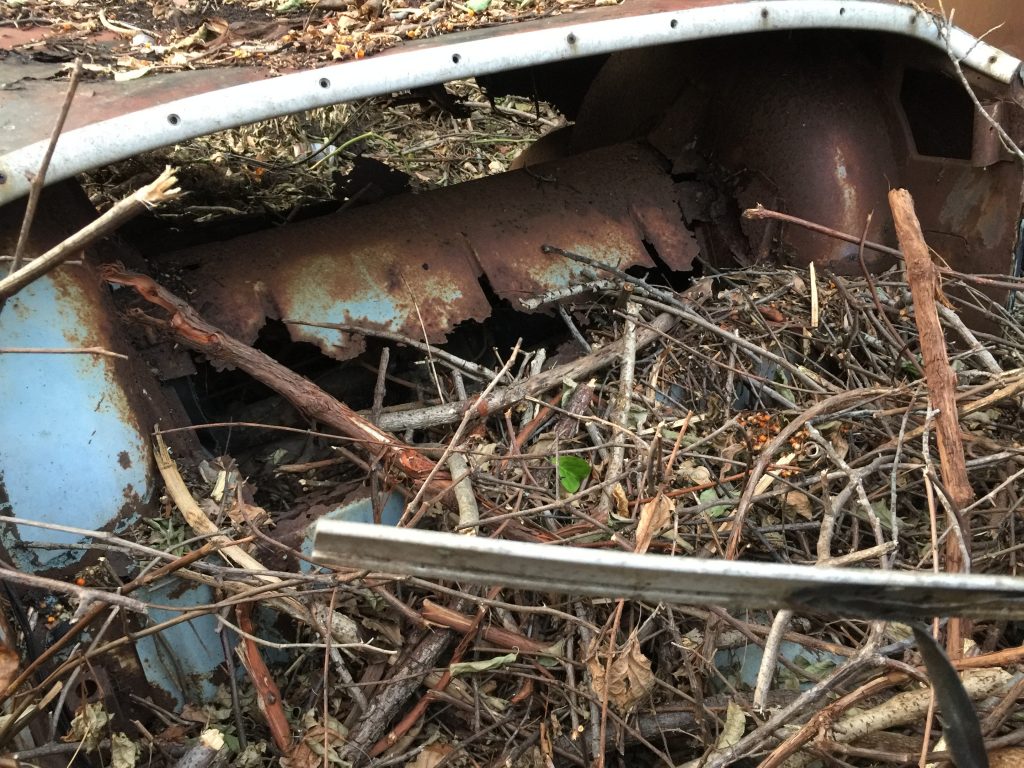
Sometimes, the raw power of nature is simply too much, even for the mighty Bugeye Sprite. Clearly, the earth is winning this battle, and soon this car will be fully digested and beyond revival by mere mortals. I paused to salute the impermanence of all things, snapped a few pictures to share, and headed home, amused by the notion of a tree that might one day sprout forth from this ground, and leak 20W-50 sap from its limbs.
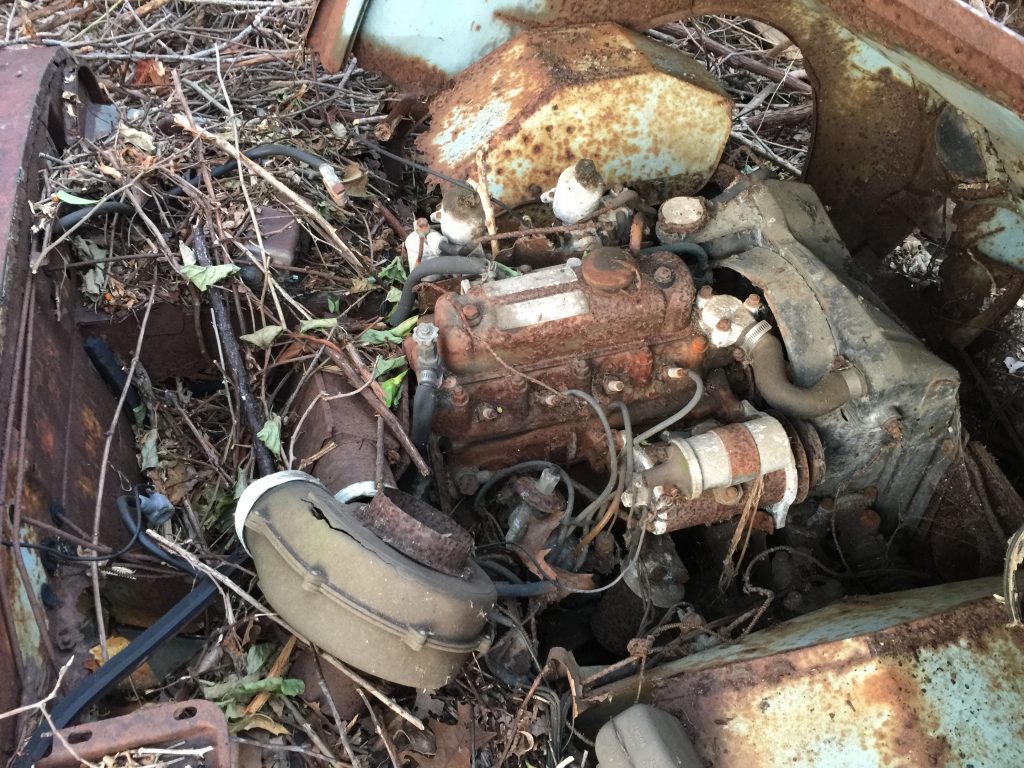
But, wait, it comes with a spare nose!
